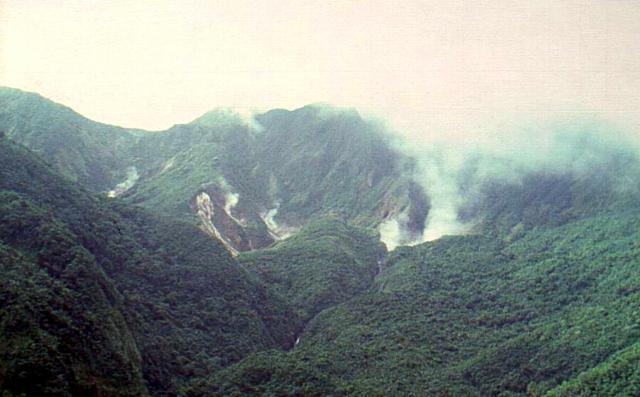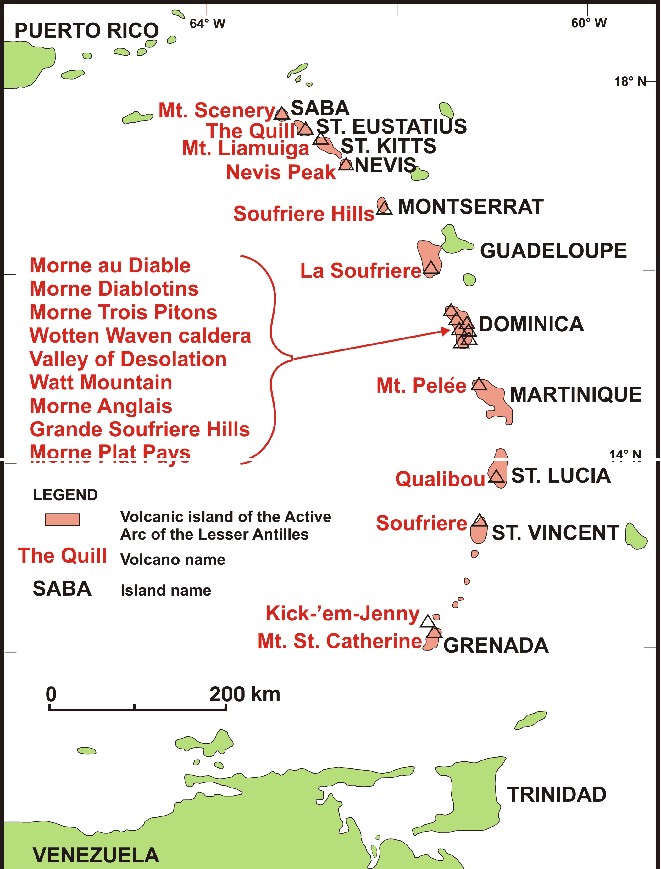Volume No. 2 Issue No. 3 - Monday June 4, 2007
The history and pictures of Dominica's volcanoes - Morne Watt
 By Thomson Fontaine By Thomson Fontaine

 The two best known volcanic features on Dominica, the boiling lake and the valley of desolation lie within the Morne Watt (Rat Mountain) range. The boiling lake is the second largest lake of its kind in the world and is a major tourist attraction. The two best known volcanic features on Dominica, the boiling lake and the valley of desolation lie within the Morne Watt (Rat Mountain) range. The boiling lake is the second largest lake of its kind in the world and is a major tourist attraction.
An arduous 3 to 4 hour hike up the mountains and through cascading rivers will reveal a constant fumarolic cloud over both the valley of Desolation and the Boiling lake. Admist the strong smell of sulphur and heated rocks, several streams of hot boiling water flows through near desolate landscape.
Over 1300 years ago, a major eruption on Morne Watt is said to have produced pyroclastic flows and may have provided the crater that later became the boiling lake.
In July 1997, a minor eruption was reported in the valley of desolation, about a mile from the boiling lake. A much larger eruption took place in 1880 when ash was spewed as much as 10 Km from the mouth of the volcano and was spread over a significant area of the south east coast of Dominica.
Morne Watt lies a few miles east of the capital Roseau and south east of the Morne Trois Pitons/Micotrin volcano range. Morne Anglais stratovolcano lies 4 km SW of Morne Watt and Grand Soufri�re Hills volcano, with dated pyroclastic-flow producing eruptions about 10,000 years ago, lies 3 km to the east.
 Nine of the Caribbean�s sixteen active volcanoes are located on the island of Dominica. By contrast there is one each on Guadeloupe, Martinique, St. Lucia, St. Vincent, Montserrat, Saba, St. Eustacius, St. Kitts, and Nevis. There are two in Grenada. Nine of the Caribbean�s sixteen active volcanoes are located on the island of Dominica. By contrast there is one each on Guadeloupe, Martinique, St. Lucia, St. Vincent, Montserrat, Saba, St. Eustacius, St. Kitts, and Nevis. There are two in Grenada.
Dominica�s nine active volcanoes are ; Morne au Diable, Morne Trois Pitons, Morne Diablotins, Morne Watts, Morne Anglais, Wotten Waven Caldera, Valley of Desolation, Grande Soufriere Hills and Morne Plat Pays.
The youngest dated volcanic deposits on the island are associated with the Morne Patates dome on the flanks of the large active Plat Pays Volcano that comprises the southwestern end of the island. This was a Pelean eruption (similar to the eruptions of Mt. Pelee on Martinique in 1902 and 1929) and radiocarbon ages from the block and ash deposits suggest it occurred about 500 year ago.
In addition there have been two steam explosions (phreatic activity) in the Valley of Desolation in 1880 and 1997. Frequent seismic swarms and vigorous and widespread geothermal activity today characterize the island. In fact it is the most worrying of all the Caribbean volcanic areas and there is a general feeling that it (like Montserrat pre-1995) is long overdue for an eruption. Scientists are predicting that there will be at least one major eruption within the next 100 years.
What is of particular concern is that the capital Roseau and most of the islands infrastructure lie on a pyroclastic flow fan derived from the Wotten Waven caldera situated on the eastern outskirts of the capital.
The pyroclastic deposits of the Roseau area abound with ignimbrites (pumiceous pyroclastic flows), surge and airfall deposits with radiocaron ages ranging from 38,000 to 1000 years B.P.
Volcanologist Haraldur Sigurdsson as long ago as 1972 described one of the units which he called the Roseau ash and together with other workers traced its submarine extension. As a result of this work they concluded that about 38,000 years ago the island erupted around 56 cubic kilometers of pumiceous materials in what was described as the largest eruption in past 200,000 years in the Caribbean.
Pyroclastic flows deposited about 30 cubic km on the Caribbean floor and the remainder was deposited on the Atlantic floor from AntiTrade Wind dispersal. More recent work suggests that there are several ignimbrite sheets separated by ancient soils and the deposits may have resulted from several eruptions. However all conclusions indicate that the capital Roseau is situated in one of the most hazardous areas of the island.
The Dominican.net will continue to bring you the history and photos of this aspect of our beautiful island over the next several issues.
Related Articles
The History of a Volcanic Island
The Morne Plat Pays (Flat Footed) Volcano
The Morne Diablotins (Little devils) Volcano
|
|





